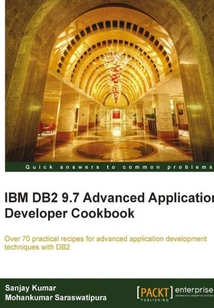舉報 

會員
IBM DB2 9.7 Advanced Application Developer Cookbook
最新章節:
Index
Thiscookbookhasrecipeswritteninasimple,easytounderstandformatwithlotsofscreenshotsandinsightfultipsandhints.IfyouareanIBMDB2applicationdeveloperwhowouldliketoexploitadvancedfeaturesprovidedbyDB2todesignandimplementhighqualityapplications,thenthisbookisforyou.ThisbookassumesyouhaveabasicunderstandingoftheDB2applicationdevelopment.
目錄(111章)
倒序
- coverpage
- IBM DB2 9.7 Advanced Application Developer Cookbook
- Credits
- About the Authors
- About the Reviewers
- www.PacktPub.com
- Support files eBooks discount offers and more
- Preface
- What this book covers
- What you need for this book
- Who this book is for
- Conventions
- Reader feedback
- Customer support
- Chapter 1. Application Development Enhancements in DB2 9.7
- Introduction
- Changing column names online using the ALTER TABLE operation
- Using the CREATE OR REPLACE clause while creating objects
- Using the ALTER TABLE operation in a single transaction
- Using the CREATE WITH ERROR support
- Using the soft invalidation and automatic revalidation support
- Using the ALTER COLUMN SET DATA TYPE extended support
- Using the new TRUNCATE statement
- Using AUTONOMOUS transactions
- Using implicit casting during application enablement
- Using the DEFAULT values and NAMED arguments in procedures
- Chapter 2. DB2 Application Techniques
- Introduction
- Granting and revoking instance-level authorities
- Granting and revoking database-level authorities
- Granting and revoking object privileges
- Implementing static SQL in DB2
- Implementing dynamic SQL in DB2
- Creating Declared Global Temporary Tables (DGTTs)
- Using XML in a declared temporary table
- Improving performance by creating indexes on a DGTT
- Creating Created Global Temporary Tables (CGTT)
- Using generated columns in tables
- Creating a savepoint
- Rolling back to a savepoint
- Using savepoints in JDBC
- Using savepoints in SQLJ
- Creating a sequence object
- Modifying a sequence object
- Referencing a sequence object
- Chapter 3. General Application Design
- Introduction
- Improving concurrency by using a connection concentrator
- Using trusted contexts for improved security
- Using trusted connections in JDBC
- Using trusted connections in PHP
- Securing data by using DB2 encryption
- Improving concurrency by using enhanced optimistic locking
- Working with user-defined types (UDT)
- Working with structured types
- Chapter 4. Procedures Functions Triggers and Modules
- Introduction
- Creating a simple stored procedure
- Using dynamic SQL in stored procedures
- Working with result sets in stored procedures
- Using ARRAY objects in stored procedures
- Handling errors in stored procedures
- Designing external stored procedures
- Using PL/SQL exception handling in a procedure
- Working with the message buffer in stored procedures
- Planning and designing triggers
- Using scalar user-defined functions
- Writing external user-defined functions
- Designing external table functions
- Working with modules in DB2
- Chapter 5. Designing Java Applications
- Introduction
- Creating connection objects in JDBC applications
- Creating connection objects in SQLJ applications
- Manipulating XML Data in Java applications
- Batch processing in JDBC applications
- Batch processing in SQLJ applications
- Working with scrollable result sets
- Handling errors and warnings in JDBC applications
- Developing Java applications for high availability
- Using SSL in Java applications
- Chapter 6. DB2 9.7 Application Enablement
- Introduction
- First step towards enabling Oracle application to DB2 9.7
- Using ROWNUM and DUAL in DB2 9.7
- Using CUR_COMMIT concurrency control isolation level
- Implementing hierarchical queries for recursion support
- Using PL/SQL ANONYMOUS block statements
- Handling RAISE_APPLICATION_ERROR in DB2 PL/SQL
- Migrating Oracle database objects on to DB2 9.7
- Porting multi-action triggers from Oracle to DB2 9.7
- Chapter 7. Advanced DB2 Application Features and Practices
- Introduction
- Working with OLAP functions
- Using optimizer profiles
- Using explain utilities
- Using section explain information
- Interpreting db2exfmt output
- Application development in partitioned databases
- Chapter 8. Preparing and Monitoring Database Applications
- Introduction
- Preparing applications for execution
- Rebinding existing packages
- Customizing application behavior using registry variables
- Monitoring application performance
- Chapter 9. Advanced Performance Tuning Tips
- Introduction
- Understanding predicates in SQL statements
- Improving INSERT performance
- Writing effective SQL statements
- Index 更新時間:2021-08-20 15:42:38
推薦閱讀
- 手機安全和可信應用開發指南:TrustZone與OP-TEE技術詳解
- R語言數據分析從入門到精通
- 案例式C語言程序設計
- JavaScript:Functional Programming for JavaScript Developers
- Mastering Natural Language Processing with Python
- JavaFX Essentials
- MATLAB 2020 從入門到精通
- 匯編語言程序設計(第2版)
- ASP.NET 3.5程序設計與項目實踐
- R Deep Learning Cookbook
- Mastering JavaScript Design Patterns(Second Edition)
- JavaScript程序設計(第2版)
- .NET Standard 2.0 Cookbook
- CRYENGINE Game Development Blueprints
- 代替VBA!用Python輕松實現Excel編程
- jMonkeyEngine 3.0 Beginner’s Guide
- Java Web開發任務教程
- Selenium WebDriver自動化測試完全指南
- R for Data Science Cookbook
- React.js 16從入門到實戰
- 我跟爸爸學編程:從Python到C++
- Flask Framework Cookbook
- Java編程方法論:響應式RxJava與代碼設計實戰
- “笨辦法”學Python 3
- Developing Responsive Web Applications with AJAX and jQuery
- 研發質量保障與工程效率
- 零基礎學Python(第2版)
- 代碼之外的功夫:程序員精進之路
- Spring Essentials
- 網頁制作教程

